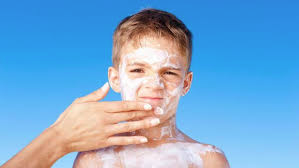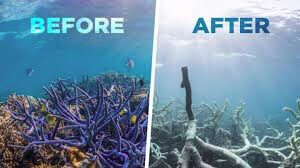THE POPULACE HAS RECOGNIZED THAT SUNSCREEN HAS BEEN WEAPONIZED AGAINST IT
Great positive changes are underway at every level of our reality. They began in earnest in 2012, and have been increasing in speed and magnitude. I began writing this series of articles, entitled “Positive Changes That Are Occurring”, in July of 2013.
These historically-unprecedented positive changes are being driven by many hundreds of thousands, if not millions of simple, inexpensive Orgonite devices based on the work of Wilhelm Reich and Karl Hans Welz.
Since Don Croft first fabricated tactical Orgonite in 2000, its widespread, ongoing and ever-increasing distribution has been unknitting and transforming the ancient Death energy matrix built and expanded by our dark masters, well, all the way back to Babylon, and before. And, as a result, the Ether is returning to its natural state of health and vitality.
One of those changes is that the populace has recognized that sunscreen has been weaponized against it.
Big Lie number one: “the sun causes skin cancer”. Over the years, numerous studies have confirmed that appropriate sun exposure actually helps prevent skin cancer. For example, A Swedish study from 2014 showed that women who avoided lying out in the sun had mortality twice that of those who sunbathed daily.
Big Lie number two: “sunscreen protects you from skin cancer”. Sunscreen causes skin cancer. There are only four prospective studies that examine sunscreen’s role in preventing skin cancer, and none of these studies examine the efficacy of sunscreen in preventing skin cancer in otherwise healthy individuals.
The hormone-disrupting chemical oxybenzone, a known caricinogen, penetrates the skin and enters the bloodstream, and acts as a photosensitizer, increasing the release of free radicals. That couples with another common sunscreen ingredient, Retinyl palmitate, which speeds the development of skin tumors and lesions when applied to the skin in the presence of sunlight.
Retinyl palmitate is a form of Vitamin A, and was selected by the FDA’s Center for Food Safety and Applied Nutrition for photo-toxicity and photocarcinogenicity testing, which showed that tumors and lesions developed 21% faster in lab animals coated in a vitamin A-laced sunscreen than animals treated with a vitamin-free cream.

Oxybenzone drives lower testosterone levels in adolescent boys, hormone changes in men, and shorter pregnancies and disrupted birth weights in babies. Of all of the sunscreen ingredients, oxybenzone is known to be the most common cause of contact allergies; a 10-year study found that 70% of people had a positive patch test when exposed.
In 2011, David Andrews, a senior scientist for the Environmental Working Group, or EWG, a consumer organization which advocates for sunscreen safety, said “It is outrageous that over a decade ago, nearly every American tested by CDC had oxybenzone in their blood, an ingredient linked to hormone disruption, and still manufacturers have resisted safety testing,” he added.
A 2006 study from the University of California, Riverside, showed that certain sunscreen ingredients caused more free radicals to form than no sunscreen at all.
Rates of melanoma doubled on a per-capita basis between 1982 and 2011.
Squamous cell carcinoma increased 45% among the general population from 2000 to 2010, while it increased 263% among women during that time. Women 30-49 experienced the greatest increase.
This while sales of sunscreen grew 4.2 percent a year from 2007 and 2014, a cumulative growth of nearly 30 percent over a period of just seven years. That means that, in ust over seven years, thirty percent more sunscreen was being applied.

“Sunscreen” was first introduced in the early 1940s as tanning lotion. The idea was that if you could stay in the sun without burning, you’d tan. A few years later, the melanoma rate began to rise. Improved tanning lotions came on the market in the early 1960s, and a few years after that, the melanoma rate zoomed up. Public health authorities became concerned, and melanoma became news. Seeing a commercial opportunity, the makers of tanning lotions repositioned their products as “sunscreen,” and the now familiar sermonizing began. Since then, melanoma has become the nation’s fastest-rising cancer and sunscreen sales have continued to climb.
There are three main kinds of skin cancer: basal cell, squamous cell, and malignant melanoma. The first two are common (about 1 million cases a year) and almost always medically minor. The American Cancer Society and the National Cancer Institute don’t even count them in the nation’s cancer statistics. Melanoma is much less common (40,300 diagnoses last year), but often fatal (7,300 deaths).
The truth is that suncreens can’t and don’t prevent melanoma, in that most sunscreens do not offer protection against UV-A, the harmful, longer-wavelength UV light that penetrates right through the outer skin—and through sunscreen—down to the melanocytes, the cells that become cancerous in melanoma cases.
In one study that proved this point, researchers at the Brookhaven National Laboratory in Upton, New York, induced melanoma in fish by exposing them to both UV-B and UV-A sunlight. They concluded: “Sunscreens effective in the UV-B region…would not protect against melanoma.”
In 1998, Epidemiologist Marianne Berwick of the Memorial Sloan-Kettering Cancer Center in New York, said that there is no evidence that sunscreen offers any real protection against malignant melanoma, the most dangerous form of skin cancer. “It’s not safe to rely on sunscreen,” Berwick told the press.
The Skin Cancer Foundation promptly refuted her findings in a press release, telling consumers that “sunscreen should continue to be an integral part of a comprehensive program” to prevent melanoma. That’s what most people will likely hear from their dermatologists as well. What they won’t learn is that dermatologists get much of their information from the SCF, and the SCF, in turn, is heavily supported by the sunscreen industry. A sunscreen manufacturer even funded SCF’s quarterly consumer publication, “Sun and Skin News. No wonder the foundation doesn’t give much credence to the growing number of studies showing that even so-called broad-spectrum sunscreen doesn’t prevent melanoma.
To prevent melanoma, sunscreen must do more than block UV-B rays—it must also protect against UV-A. As a result, sunscreen makers have tinkered with their formulas, and now most claim that their products provide broad-spectrum UV-A and UV-B coverage. Sounds good, but it’s actually another sleight of hand on the part of sunscreen manufacturers. Only one ingredient, avobenzone, is “clearly proven” to block UV-A sunlight, and according to FDA spokeswoman Ivy Kupec, the FDA doesn’t require its inclusion in sunscreens in order for manufacturers to claim that their products offer broad-spectrum protection. (“I guess there’s an inconsistency,” she notes.) Kupec added that manufacturers “could still say [their product] protects against UV-A, because they can do it until we tell them not to.” So much for regulatory protection.
Unlike in Europe, U.S. regulations allow sunscreen makers to sell products that filter out UVB to prevent sunburn, but provide less protection against DNA-damaging UVA. In the U.S., we let the UVA that causes malignant melanoma right through, and make sure that the most deadly and absorbable of the ingredients, oxybenzone, is included.
“If you just use a sunscreen that just protects against sunburn,” said David Andrews, a senior scientist at the nonprofit Environmental Working Group, which recently published a comprehensive report on sunscreens, “you are effectively getting the same sun exposure as you would from a tanning bed.”
Even if sunscreen blocked UV-A completely, almost no one uses it in the way that grants real protection against sunburn. For sunscreen to live up to its hype, you have to slop it on real thick and reapply it every few hours. We’re talking at least one full bottle per person per day at the beach. Meanwhile, the vast majority of sunscreen users apply a thin layer once or twice.
Until around 1950, melanoma was rare. Then its incidence increased slowly until the mid-1960s, when it accelerated into the current epidemic. The standard, pro-sunscreen explanation is that, like lung cancer, the disease has a long lag time, on the order of 20 years. Americans began sunbathing in earnest in the 1950s, and as a result, the melanoma epidemic hit in the 1970s.
However, research indicates that the lag time could be as low as two years. Melanoma diagnoses reflect seasonality - at least five studies of melanoma (in Hawaii, the continental U.S., Sweden, Norway, and England and Wales) all agree that melanoma diagnoses follow a seasonal pattern, showing up at a considerably higher rate in summer than in winter. Seasonality is a hallmark of biological events with short lag times.
Beaches around the country were jammed on summer weekends in the 1930s. Why didn’t a melanoma epidemic hit the Depression generation 20 years later? Why did it take until the mid-1970s for the epidemic to strike? Sunscreen promoters offer no clue.
If melanoma has a 20-year lag time and sunscreen is protective, the melanoma rate should have started to level off by now. Instead, it’s climbing. In 1980, an American’s lifetime melanoma risk was 1 in 250. Today, it’s 1 in 84.
The idea of hysterical helicopter moms driving their kids to the bus stop and then standing there to witness them getting on the bus willfully pretending that they have no idea any of this is happening is a key part of the dilemma facing us as a species.
As a bonus, not only do sunscreens drive the skin cancer that it is claimed they prevent, they also destroy coral reefs. The “reef bleaching” that’s tirelessly blamed on “global warming” is actually driven by sunscreen use.
The chemicals in sunscreen are toxic to coral reefs. Just a small amount of certain chemicals is enough to cause corals to bleach, losing their symbiotic algal energy source and become more susceptible to viral infections.
Certain preservatives in sunscreens can also be toxic to reefs and humans. Parabens such as the commonly used methyl paraben and butyl paraben are fungicides and anti-bacterial agents that extend the shelf life of a product. Phenoxyethanol was originally used as a mass fish anesthetic.
An estimated 14,000 tons of sunscreen is believed to be deposited in oceans annually.

Hawaii, the Pacific nation of Palau and Key West have banned sunscreens containing oxybenzone and octinoxate because they cause coral bleaching and are dangerous to marine ecosystems.
The percentage of U.S. teenagers using sunscreen dropped 12% in the ten years from 2001 to 2011.
As of 2015, only a third of the public used sunscreen.
At the most basic level, sunscreen prolongs people’s time in the sun by preventing the only natural warning system human skin has—sunburn.
The only proven way to prevent melanoma is to cover up. Our forebears did so in the days before sunscreen. Clearly it worked because melanoma was so rare. Queensland province, in northeastern Australia, has the highest melanoma rate in the world. In 1981, public health authorities in Queensland, Australia began a big-budget PR campaign promoting sunscreen.
A few years ago, they shifted the campaign’s focus to strongly encourage people to cover up and stay in the shade, and melanoma rates there began to flatten.
In retrospect, it will have taken roughly seventy years from the inception of this diabolical scam to its collapse. That scam being a product created specifically to increase skin cancer rates, while being advertised as preventing skin cancer.
It’s February 2021, and the populace has recognized that sunscreen has been weaponized against it.
Jeff Miller, Brooklyn, New York, February 1, 2021
If you’d like to be added to this free mailing list, or know someone who would be, please send me a note at [email protected]
You can access these articles online at https://forum.orgones.co.uk/c/positive-changes-that-are-occurring/